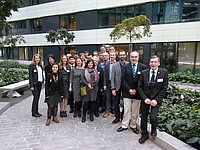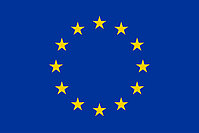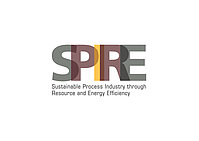The CO2EXIDE project aims at the development of a combined electrochemical-chemical technology for the production of ethylene oxide from biobased CO2. Initially, the electrochemical step pursues the simultaneous conversion of CO2 to ethylene at the cathode and water oxidation to hydrogen peroxide at the anode. A subsequent chemical conversion of both intermediates to ethylene oxide will deliver e.g. oligo-/polyethylene glycol in a chemical cascade reaction. The CO2EXIDE technology combines a modular nature for the feasibility of a decentralised application, a high energy and material efficiency/yield and the substitution of fossil based production of ethylene oxide. In line with the energy turnaround, the CO2EXIDE technology will be combinable with renewables and allows for the direct creation of products, which can be integrated into the existing supply chain. The reactions will be operated at low temperatures and pressures and forecast significant improvements in energy and resource efficiency combined with an enormous reduction of GHG emissions. All improvements will be quantitated using life cycle assessment.
The CO2EXIDE approach will bring together physicists, chemists, engineers and dissemination and exploitation experts from five universities/research institutions, three SMEs and two industries, innovatively joining their key technologies to develop and exploit an unprecedented process based on CO2, renewable energy and water to connect the chemical and energy sector. The project was funded by the EU in cooperation with SPIRE. This project has received funding from the European Union’s Horizon 2020 research and innovation programme under grant agreement No 768789.
Partners:
No | Participant organisation name | Country |
1 (Coord.) | Fraunhofer Institute for Interfacial Engineering and Biotechnology IGB | Germany |
2 | AGH University of Science and Technology, Academic Centre for Materials and Nanotechnology, Kraków | Poland |
3 | Institute of Solid State Physics of the University of Latvia | Latvia |
4 | Budapest University of Technology and Economics, Department of Atomic Physics | Hungary |
5 | University of Southampton | UK |
6 | Schaeffler Technologies AG & Co. KG | Germany |
7 | Siemens AG | Germany |
8 | Energieinstitut an der Johannes-Kepler-Universität Linz | Austria |
9 | axiom Angewandte Prozesstechnik Ges.m.b.H. | Austria |
10 | EPC - PROJEKTGESELLSCHAFT FÜR KLIMA. NACHHALTIGKEIT. KOMMUNIKATION. mbH (gemeinnützig) | Germany |
The role of the Institute of Solid State Physics, University of Latvia (ISSP UL) in the project is to create an alternative structure of the cathode for electrocatalytic reduction of CO2 to ethylene, based on modified multi-layer graphene stacks obtained from recycled graphite. In addition, the ISSP UL will perform theoretical calculations from the first principles of the graphene sheet modified with copper atom clusters, and will construct innovative electrochemical half-cell to monitor with FTIR spectroscopy the gases in CO2 reduction process. SPEEK polymer composites with zirconium oxide nanoparticles and ionic liquid derived from imidazole compounds will be developed to form a membrane that is compatible with the catalyst materials and stimulates the adsorption of the CO2 on the electrode.
Three laboratories - Laboratory of Materials for Energy Harvesting and Storage (Dr. Janis Kleperis), Laboratory for Computer Modeling of Electronic Structure of Solids (Dr. Yuri Zhukovskii) and Chemistry Laboratory (Dr. Guntars Vaivars) participate in the project from the ISSP UL.
Project progress
June 15, 2018
3 students from CO2EXIDE`s Latvian group – young researchers of Institute of Solid State Physics of University of Latvia: PhD students Ainars Knoks and Peteris Lesnicenoks, and Bch student Ingars Lukosevics will participate in the 2018 E-MRS Spring Meeting from June 18th to 22nd in Strasbourg Convention Centre (France).
A plenary session to provide an international forum for discussing recent advances in the field of materials science will be organized. The conference will be augmented by an exhibition of products and services of interest to the conference participants.
The 2018 E-MRS Spring Meeting consist from 6 sections: https://www.european-mrs.com/meetings/2018-spring/symposia-program and is divided in 29 parallel symposia with invited speakers, oral and poster presentations.
Sections:
- MATERIALS FOR ENERGY AND ENVIRONMENT
- BIOMATERIALS AND NANOMEDICINE”
- SEMICONDUCTORS AND NANODEVICES
- NANOMATERIALS
- FUNCTIONAL MATERIALS
- MATERIAL PROCESSING AND CHARACTERIZATION
In the conference Latvian young researchers will present poster reports in section “Functional Materials”:
- “Graphene sheet stacks for electrodes – recycling to new qualities” by Peteris Lesnicenoks, Janis Kleperis, Ingars Lukosevics, Laimonis Jekabsons, Maris Knite, Astrida Berzina (subsection T - Engineering of functional materials with chemical coating methods).
- “Spectroscopic investigation of Metal catalyst influence on ElectroCatalytic CO2 reduction – streamline investigation” by Ainars Knoks, Janis Kleperis, Liga Grinberga, Peteris Lesnicenoks, Julija Hodakovska, Georgijs Cikvaidze, Martins Vanags and Artis Volkovs (subsection T - Engineering of functional materials with chemical coating methods)
- “Durability study of graphene sheet stack and nitrocellulose composite with surface mounted copper structures as electrode” by Ingars Lukosevics, Peteris Lesnicenoks and Janis Kleperis (subsection R - Solid state ionics: advanced functional materials for solid state devices)
European Material Research Society (E-MRS) now has more than 4,000 members from industry, government, academia and research laboratories, who meet regularly to debate recent technological developments of functional materials. The E-MRS differs from many single-discipline professional societies by encouraging scientists, engineers and research managers to exchange information on an interdisciplinary platform, and by recognizing professional and technical excellence by promoting awards for achievement from student to senior scientist level.



